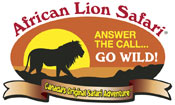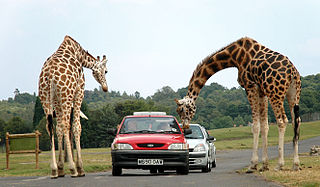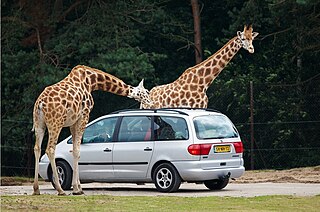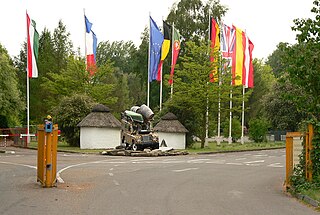
Lion & Safari Park is a conservation enclosure for lions, cheetahs, hyena, wild dogs and various antelope. It is located in the Cradle of Humankind in the North West province of South Africa.

Lion & Safari Park is a conservation enclosure for lions, cheetahs, hyena, wild dogs and various antelope. It is located in the Cradle of Humankind in the North West province of South Africa.




The Lion & Safari Park was originally a wildlife conservation enclosure for lions located in the Gauteng province in South Africa. In 2016, the park relocated to new premises of 600 hectare (ca. 1,500 acre) in the Cradle of Humankind in the North West province. The park is situated north of Lanseria Airport within driving distance of Johannesburg and Pretoria. It has a large variety of predators and large herbivores indigenous to Africa.
The Lion & Safari Park is home to over 80 lions including the rare white lions and many other carnivores such as South African cheetah, Cape wild dog, brown hyena and spotted hyena, black-backed jackal, and a wide variety of antelope which roam freely in the antelope area. [1]
The antelope area, containing giraffe, warthog, blesbok, wildebeest, impala, gemsbok, and zebra, is a separate area away from the lions and other carnivores.
In addition to the animal enclosures the new park has a children's play area, restaurants, conference facilities and a retail centre within five small domes. Guests are also able to hand-feed giraffes, ostriches and antelope. [2]
Twice a day the park also offers Lion walks and Cheetah walks in which clients, in the company of a park employee, follow the animal for a short walk within the park. [2]
Cub interactions involve the clients being in a separate enclosure with a lion cub for a short period of time during which photos can be taken and minimal interaction with the animal is possible.
In 2015 the Lion & Safari Park banned cub interactions but found that visitor numbers dropped dramatically as people were going to other places that still offered cub interactions. In 2016 cub interactions were re-introduced as an additional part of a guided tour at the new premises of the park. The CEO, Rodney Fuhr, said that they had no choice since the "survival of our business will be at stake." [3]
Non-profit organisation, Blood Lions, which is opposed to the exploitation of lions in any form, condemned the park and those who chose to visit it for the cub interactions. The park believes that they are managing the interactions with the cubs in a way that will not have a negative impact on the cubs. [3]
On June 1, 2015, Katherine Chappell was visiting the original location of the park in the company of a tour operator, Pierre Potgieter of Kalabash tours. [4] Chappell had opened her window and leant out to take photographs, against park rules, when a lion lunged through the window of the vehicle and bit her on the neck. Chappell died in the Lion Park of her wounds before the paramedics arrived. [5] Potgieter fought off the lion and suffered injuries to his arms and an unconfirmed heart attack. [4]
Chappell had been visiting South Africa to work on the conservation of wildlife, [6] and was raising funds for Wildlife ACT, a conservation charity. [7]
Unfortunately, this attack was not an isolated incident. In April 2015, an Australian named Brendan Smith, was attacked by a lion when he opened his car window. Smith survived the attack and later admitted that he was at fault for opening his window. [8]
Two days after the Australian incident a local boy rode through the park on his bicycle after having cut a hole in the fence. He was attacked by a cheetah but also survived. [9]

Maasai Mara, also sometimes spelled Masai Mara and locally known simply as The Mara, is a large national game reserve in Narok, Kenya, contiguous with the Serengeti National Park in Tanzania. It is named in honor of the Maasai people, the ancestral inhabitants of the area, who migrated to the area from the Nile Basin. Their description of the area when looked at from afar: "Mara" means "spotted" in the local Maasai language, due to the many short bushy trees which dot the landscape.

The San Diego Zoo Safari Park, originally named the San Diego Wild Animal Park until 2010, is an 1,800 acre zoo in the San Pasqual Valley area of San Diego, California, near Escondido. It is one of the largest tourist attractions in San Diego County. The park houses a large array of wild and endangered animals including species from the continents of Africa, Asia, Europe, North and South America, and Australia. The park is in a semi-arid environment, and one of its most notable features is the Africa Tram, which explores the expansive African exhibits. These free-range enclosures house such animals as antelopes, giraffes, buffalo, cranes, and rhinoceros. The park is also noted for its California condor breeding program, the most successful such program in the United States.

African Lion Safari is a family-owned safari park in Southern Ontario, Canada, straddling the cities of Hamilton and Cambridge, located 100 kilometres (62 mi) west of Toronto. Guests may tour seven game reserves, with a total area of about 740 acres, on tour buses or in visitors' own vehicles, where animals roam freely in contained areas. Accompanying the game reserves is a walking section where exotic birds and primates, as well as the park's herd of Asian elephants, are on display.

West Midland Safari and Leisure Park is a safari park located in Bewdley in Worcestershire, England. It was opened under the name of West Midland Safari Park in spring 1973.

Ruaha National Park is a national park in Tanzania. The addition of the Usangu Game Reserve and other important wetlands to the park in 2008 increased its size to about 20,226 km2 (7,809 sq mi), making it the largest protected area in Tanzania, as well as in East Africa.

Windsor Safari Park was a popular family attraction built on St Leonard's Hill on the outskirts of the town of Windsor in Berkshire, England; it has since been converted into the site of Legoland Windsor. Billed as "The African Adventure", the park included drive-through animal enclosures, aviaries, a dolphinarium and minor theme park rides.

Gambella National Park, also spelled Gambela National Park, is a 5,016 km2 (1,937 sq mi) large national park in Ethiopia. It is the nation's largest national park and is located several hundred kilometers from Addis Ababa. It was established in 1974, but is not fully protected and has not been effectively managed for much of its history.

A safari park, sometimes known as a wildlife park, is a zoo-like commercial drive-in tourist attraction where visitors can drive their own vehicles or ride in vehicles provided by the facility to observe freely roaming animals.

Liwonde National Park, also known as Liwonde Wildlife Reserve, is a national park in southern Malawi, near the Mozambique border. The park was established in 1973, and has been managed by the nonprofit conservation organization African Parks since August 2015. African Parks built an electric fence around the perimeter of the park to help mitigate human-wildlife conflict. In early 2018, the adjacent Mangochi Forest Reserve was also brought under African Parks' management, almost doubling the size of the protected area.

Khaudum National Park is an isolated Nature Reserve situated in the Kalahari Desert at the west of the Caprivi Strip in northeast of Namibia. It is a very remote and inaccessible reserve but is home to some magnificent animals such as the lion and the hyena. The park also has a campsite for visitors.

Woburn Safari Park is a safari park located in Woburn, Bedfordshire, England. Visitors to the park can drive through exhibits, which contain species such as southern white rhino, elephants, tigers and black bears. It is part of the estates of the Duke of Bedford that also includes Woburn Abbey and its 3,000-acre (1,200 ha) deer park. The Safari Park itself covers 360 acres (150 ha).

The Serengeti-Park in Hodenhagen, Lower Saxony, is a zoo and leisure park in North Germany.

The wildlife of Zimbabwe occurs foremost in remote or rugged terrain, in national parks and private wildlife ranches, in miombo woodlands and thorny acacia or kopje. The prominent wild fauna includes African buffalo, African bush elephant, black rhinoceros, southern giraffe, African leopard, lion, plains zebra, and several antelope species.

The Timbavati Private Nature Reserve is located at the border line between Hoedspruit and Acornhoek, north of the Sabi Sand Private Game Reserve on the western edge of Kruger National Park. Geographically and politically, Timbavati is located in Mpumalanga Province. In Xitsonga, the name 'Timbavati' means "the place where something sacred came down to Earth from the Heavens", and refers to the rare white lions of Timbavati.

Safari West is a 400-acre (160 ha) private wildlife preserve located 12 miles north of the city of Santa Rosa in Sonoma County, California, United States.
AmaZulu Game Reserve, is located in the KwaZulu-Natal, province of South Africa and has an area of about 10.000 hectares.
Moditlo Private Game Reserve forms an integral part of the 10 000 hectare Blue Canyon Private Game Reserve, located near Hoedspruit, Limpopo Province, South Africa. The reserve borders Kapama Game Reserve to the eastern side, the Drakensberg Mountains forms the backdrop to the west, and falls into the southern/central region of the Greater Kruger Park biosphere. The size of the Blue Canyon Conservancy has now reached 36,000 acres in total, and is home to typical African game such as lions, elephants, leopards, rhinos, cheetahs, hippos and several hundreds of bird species typical to the lowveld in South Africa. The reserve is also home to a pack of wild dogs, which is the second rarest carnivore species in Africa with only an estimated 2000 remaining specimen in existence.
The Lionshare Educational Organization (LEO) Zoological Conservation Center was an off-exhibit, nonprofit wildlife reserve and breeding facility in Greenwich and Stamford, Connecticut.

The East African cheetah, is a cheetah population in East Africa. It lives in grasslands and savannas of Tanzania, Kenya, Uganda and Somalia. The cheetah inhabits mainly the Serengeti ecosystem, including Maasai Mara, and the Tsavo landscape.
Katherine "Kate" Chappell was an American film visual effects editor who worked on Game of Thrones. On June 1, 2015, she died after being attacked by a lioness in Johannesburg.
| Wikimedia Commons has media related to Lion Park . |
Coordinates: 25°50′26.88″S27°53′13.2″E / 25.8408000°S 27.887000°E